Guitar warm-up is something you’d need to do every day before playing. Many players, especially beginners, forget about this and think that professional players won’t need to exercise or stretch or do simple warm-ups before shows or before playing.
But this is wrong. You will have to do regular warm-ups regardless of your skill level. There are plenty of useful techniques and runs that you can do before every session that will help you improve as well as a warm-up when you start playing. This will improve your productiveness as well as lower the chances for potential injuries.
if you feel like your fingertips are not strong enough while playing then make sure to check my 11 Easy Tips on How To Toughen Up Your Fingertips
How Do You Warm-Up For The Guitar?
The point of warming up for the guitar is simple. You will do the same thing any athlete would do before their discipline. If you ever watched the Olympics, you probably saw runners stretch or do a little warm-up before the race. You will do the same thing. Usually, warming up for guitar is running scales, chord shapes, or any other exercise before playing.
Do Something You Already Know
The first warm-up for beginners would be to simply use something that is familiar to you. Something that you practiced and something you know well. Whether it is a scale, a chord shape, or a certain picking pattern. While it might be difficult for beginners because they have not familiarized well with the guitar yet. If you are a beginner and can’t seem to find your first warm-up, then this is a great article to get you up to speed.
Scales Exercises
Scales exercises are any exercises where you would use a scale in a certain pattern. It doesn’t matter if it is a major, minor, pentatonic, blues, or any other type of scale. The patterns may vary and they are usually repetitive and designed to memorize the scale better.
Chromatic Scale
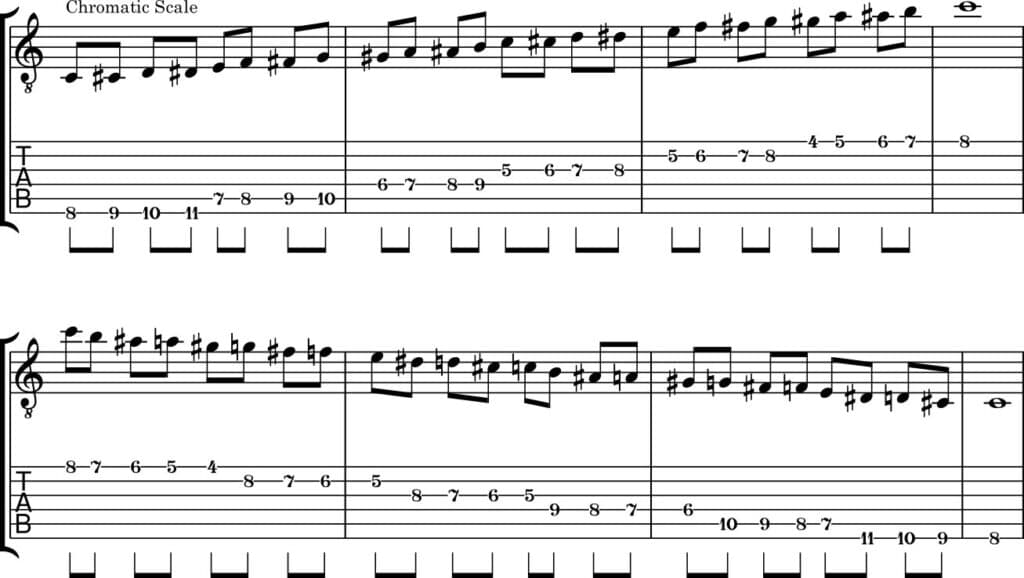
A chromatic scale is usually perfect for exercise. The reason for this is that this scale has every note and semi-note on your guitar. If you start playing on the low E string and play every fret until the twelfth, you will have played E chromatic scale. It’s simple, isn’t it? We will use this across all six strings for finger practice.
By starting from, let’s say, C note on the low E string, you can play four notes on each string and do a little run across the neck playing every note across all six strings. After you played an entire chromatic scale, you can just do the same thing to return from where you started for a whole exercise.
Chromatic scales are perfect for practice because you’ll use all four fingers, and you’ll learn and practice how to play using all four fingers. One of the useful rules is “one finger, one fret”
Furthermore, you can practice this chromatic scale using only hammer-ons and pull-offs with one pluck per string.
Minor Pentatonic Scale
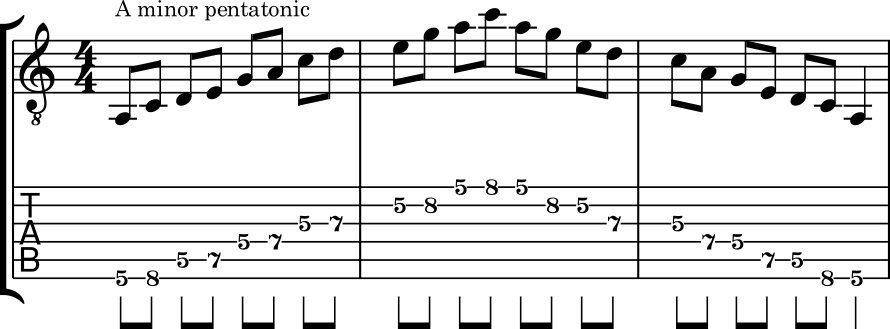
Pentatonic scales have, as the name suggests, five notes per scale. You can use this extended pattern to practice A minor pentatonic scale ascending and descending. What is good about the guitar is that you can move everything one fret down and you’ll get A# minor! Practice this scale in every position.
A pentatonic scale is a go-to scale for many players. You’d be surprised to know how many famous solos are played using the pentatonic scale only. It’s one of the easiest scales, and it will always sound beautiful.
if you are looking for your next gear or an accessory that can improve your playing experience but you are not sure what it is exactly, make sure to check my post Top 27 Must Have Guitar Accessories For Every Guitarist
Major Scale
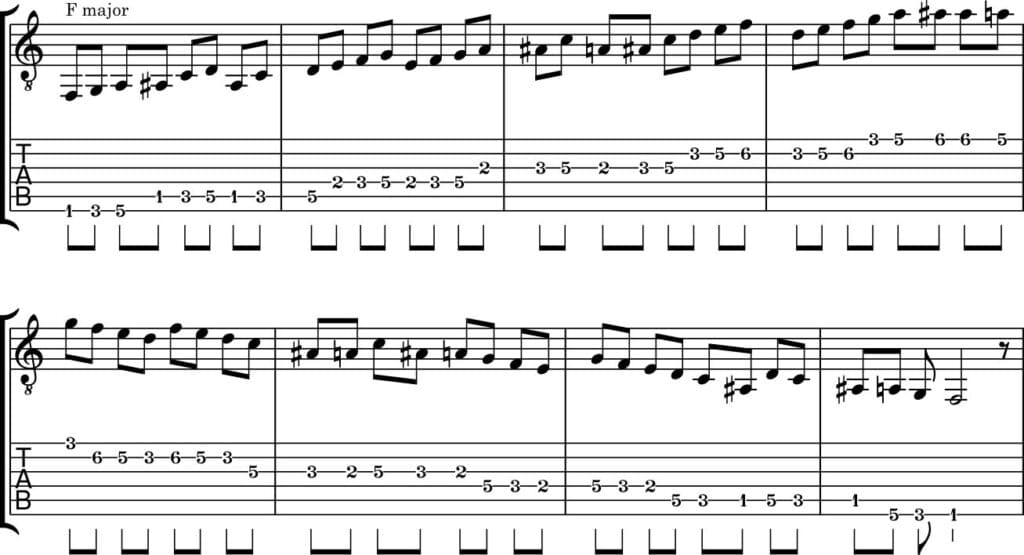
One of the best exercises for any type of player level is a major scale run. If we take F major, for example, you will have to do a bit of stretching, as well as practice some different techniques. Running up and down the scale, along with a certain repetition could be an amazing thing for you. Furthermore, you can combine this exercise with other techniques like legato, or basically anything.
While playing on the top of the neck for F major, F#, G, and so on, you will have to stretch your fingers a bit. If you play it properly and using all of your fingers, it will do wonders.
Furthermore, you can continue to use this practice with other scales, moving it up and down the fretboard. If you take this scale, which can be played with the “three notes per string” method that many famous players use, you will surely be satisfied.
Guitar Chords Exercises
Using guitar chords exercises will help you with switching between chords. All of us had trouble at the beginning and sometimes finger position is not helping when we are trying to play some cords. By using these exercises, you will master the chord switching and you’ll be able to play any song or any chord progression.
Chord Switching
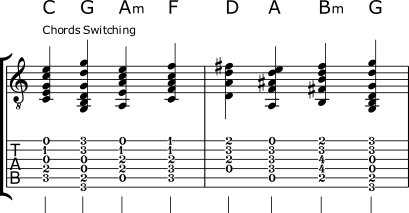
Depending on the chords you know, you can always do a little chord run. It doesn’t matter if the chords are minor, major, or any other type. Just play several chords and practice switching between them. If you know some barre chords, you can practice them on different positions up and down the neck. If you know only open chords, play them. We all know how difficult that change from C to G can be.
For more chord switching exercise, check out my post 17 Tips & 5 Exercises To Improve Your Guitar Chord Changing
Strumming Patterns

One of the most important things when it comes to guitar playing is rhythm. You should take some time to practice some strumming patterns to perfect your rhythm techniques. One of the most popular patterns is using the combination of upstrokes and downstrokes. Try playing two downstrokes, two upstrokes, one down, one up. Or any combination that you might imagine. The longer you practice, the more you’ll understand the rhythm and strumming techniques.
It is always a good idea to find the song that you love, and experiment with those chords. You can try different chord progressions and different strumming techniques. Whatever you choose, it will help you with the warm-ups.
For more information about chord progressions, check out my post 24 Guitar Chord Progression You Must Learn (Common, Rock, Sad, Jazz)
Right-Hand Exercises
String Skipping
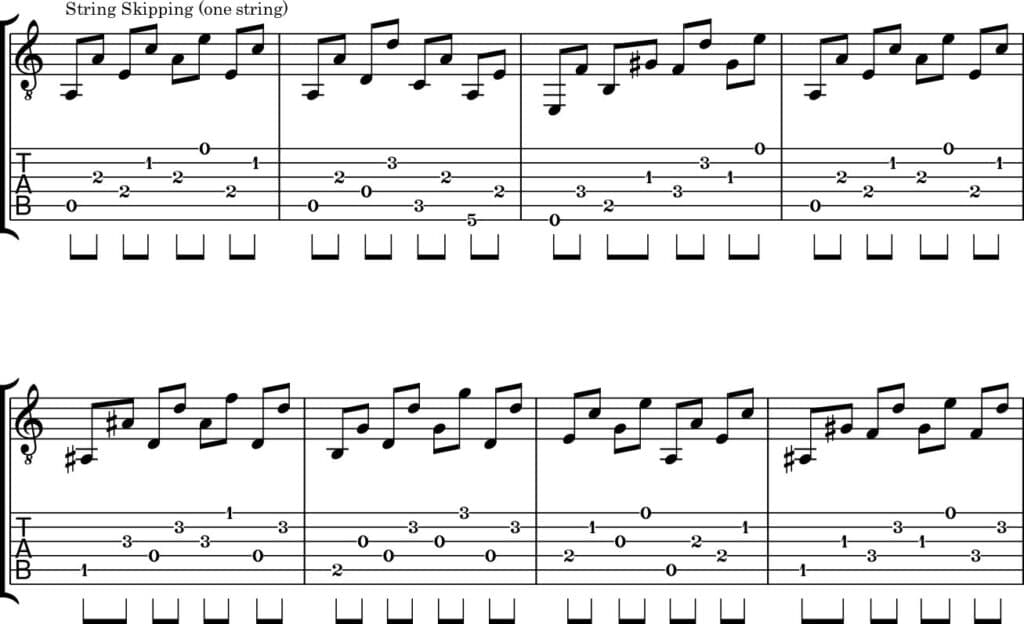
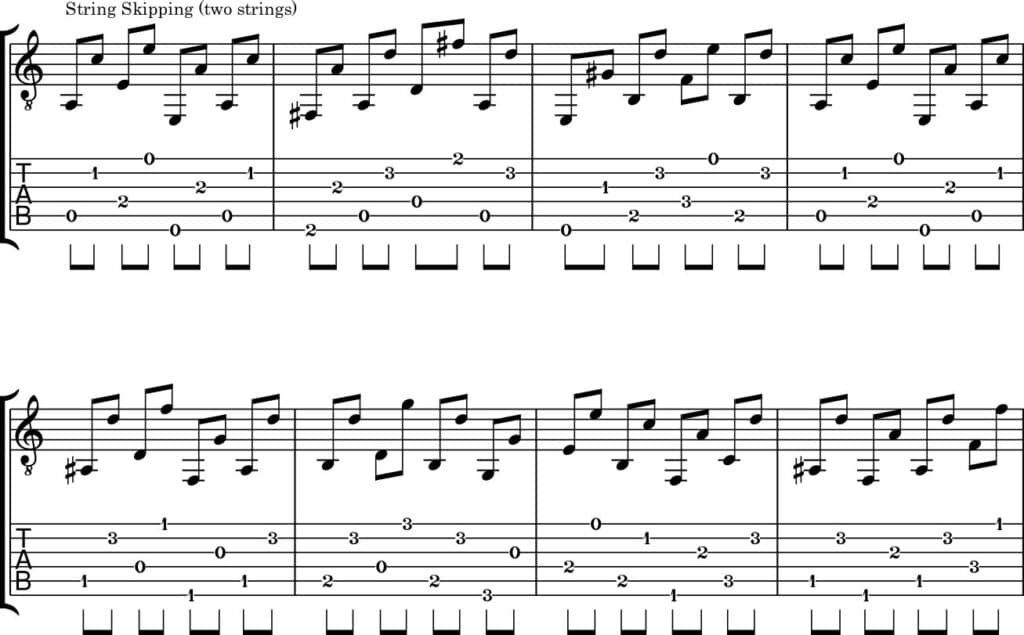

String skipping is great for both beginners and intermediate players. Since guitar pick is your tool, you should master it as soon as possible. String skipping is a technique where you will skip one or even two strings between notes. So instead of playing something on the first string, and then going to the second, you will go to the third or fourth instead.
This is great for perfecting both coordination and picking hand as well.
One of the best examples of string skipping is while playing etudes, you can try both one and two strings skipping, as well as three strings. Coordination with your picking hand is something you’ll need to practice. And you’ll need to practice it a lot. So mix some chords along with those string skipping patterns, you might find it beautiful.
Accent Patterns

If you noticed that while you’re playing a certain pattern (especially strumming), that it might get a bit boring, there is a great thing you could do. By accenting certain notes or certain strums, you will breathe a new life into your boring exercise.
For example, if you’re playing a 4/4 strumming pattern, where you use upstrokes and downstrokes. You will use one upstroke and one downstroke per beat, which will mean that you’ll have a total of eight strums. Now, if you play it only using ups and downs, it will sound dull. You can always accent a certain beat.
When we say “accenting”, we mean that you will hit that note or strum a bit harder, to make it louder or accented. If you take that common beat patterns, you will have 1 & 2 & 3 & 4 & where numbers would be your downstrokes, and “&” would be your upstrokes. What you should do, is an accent, for example, 2 and 4. You will immediately get a different sounding pattern that’s full of life.
Three Notes Per String Exercise
One of the most popular theories and techniques is playing three notes per string. You can start with that F major scale and go on practicing modes and scales on different positions. The best thing about this technique is that you’ll learn your fretboard really well.
Left-Hand Exercises
Now, most of these exercises won’t sound like a musical masterpiece. But that is not their point and their goal. The goal is for you to stretch and warm-up your fingers and your hands.
Finger Dexterity

Most of the dexterity practices will sound really bad and out of tune, but you will see the shapes and the switches between the notes and you’ll realize what their goal is.
Legato
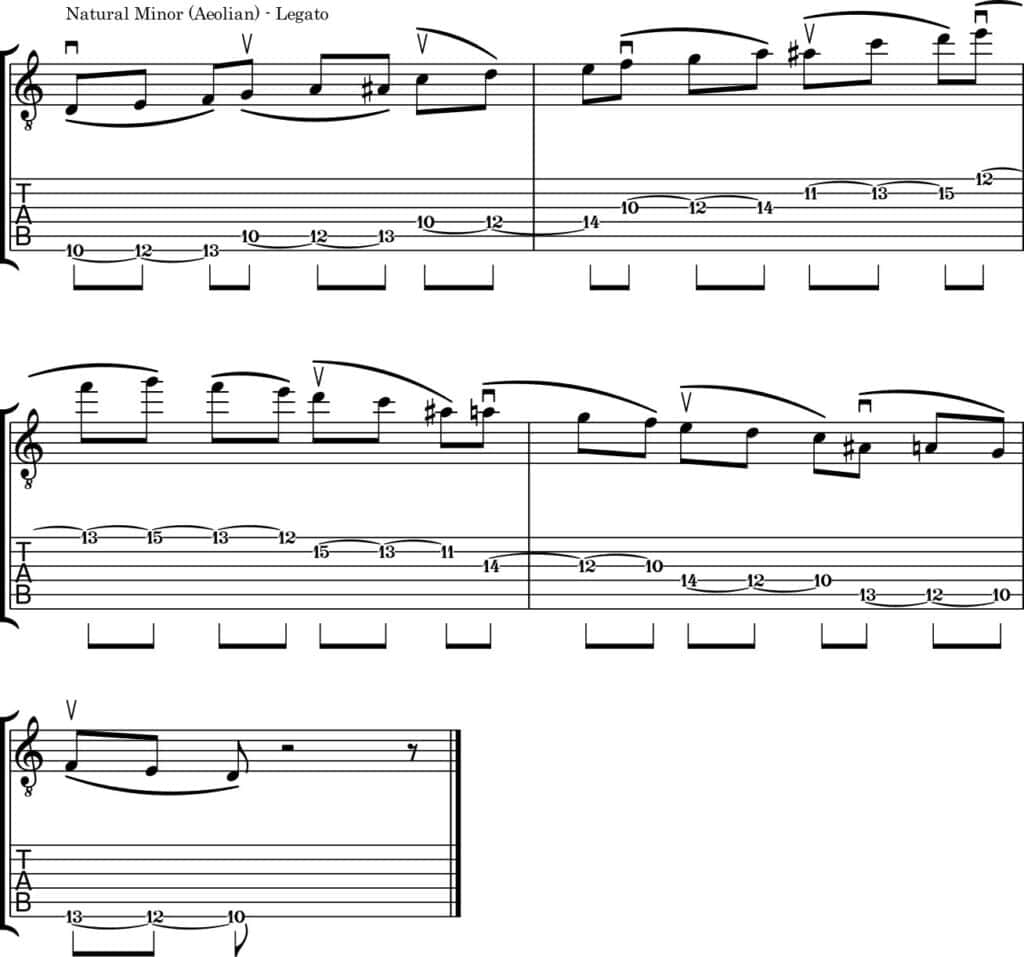
The legato playing got popular in the ’80s thanks to Eddie Van Halen. The technique is based on playing as many possible notes without picking them. Like we mentioned before, you would use hammer-ons and pull-offs for getting the sound from every note.
If we take a look at the chromatic scale or the A minor scale. You would pluck the high E string once, and then you would pull off every other note on that string. When and if you want to go to the next string, for example, the B string. You would hammer-on that string and continue the pattern.
But what is hammer-on and pull-off, anyway? If you take two notes, for example, A and B on the high E string, which is the fifth and seventh fret. If you were plucking the notes, you would play the A, and then put your finger on the B note and pluck again. But if you put your finger on that B note harder you will still hear the note. That is a hammer-on. Pull-off is the opposite technique, where you’ll use that finger on the B note to pluck it down and go back to that A without plucking it. Combining these two will get you quite a lot of speed without the need to pluck every individual note.
Finger Stretching

When it comes to finger stretching, you could always try one of the exercises designed to help you with this. You will practice this exercise while using your index finger and your middle finger. Try to stretch as much as possible. After that switch to index and ring finger and repeat the whole exercise. Finally, use index and pinky and repeat the exercise. The trick is to stretch as much as you can. Ideally, you’d go up to tenth fret or higher. But take your time.
Hand Stretching
While we already talked about exercises for finger dexterity, it might be a good idea to physically stretch your fingers before playing. Washing your hands before playing is always a good idea. If you use hotter water, you will surely keep your blood pumping. In addition, your guitar will remain cleaner for a longer period. But be sure to dry your hands before playing.
Physically stretching your fingers, both before and after playing is something that should become a habit.
Conclusion
The repetitive patterns, scales, and exercises are amazing for stretching. Beginners usually hate these things that look useless, but they are great for so many things. Whether you’re a beginner or intermediate player, you will need to do your warm-ups. Scales are usually the best way to go. You can use one of the examples we mentioned, or you can use any other scale. Improvise, experiment, and practice. Try to invent different exercises by skipping notes or strings while playing regular scales. And what is most important is- just keep playing and practicing.
If you found this article useful, you may want to save this pin below to your Guitar board.

6 thoughts on “13 Easy Guitar Warm Ups Exercises That Will Improve Your Skills”
Leave a Reply to Jacob Cancel reply
Recent Posts
When learning new songs have you noticed that some of the chord sequences sound really good? But when you tried to come up with your own chord sequence, or as we call it chord progression, you found...
Some guitarists insist on buying an expensive amplifier with their electric guitar. They assume that this is a must for every type of guitarist out there. However, in some situations, this isn’t...

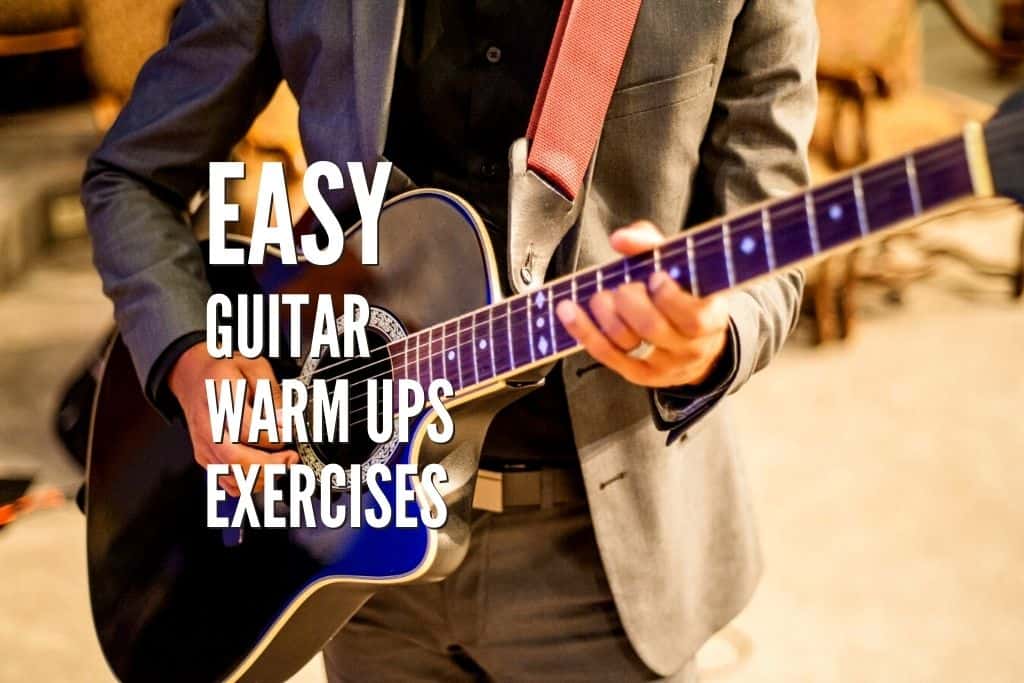
Excellent
Thanks 🙂
stay tuned for more awesome content like this 😀
This seems awesome…I shall give it a whirl !!!
Enjoy! hope it helps 🙂
i have been playing guitar for over 4.5 years now and i do these exercises and simple variations every day and they keep my hand and fingers in good shape always. These are excellent tips. keep up the good work.
Thank you! Keep on playing!